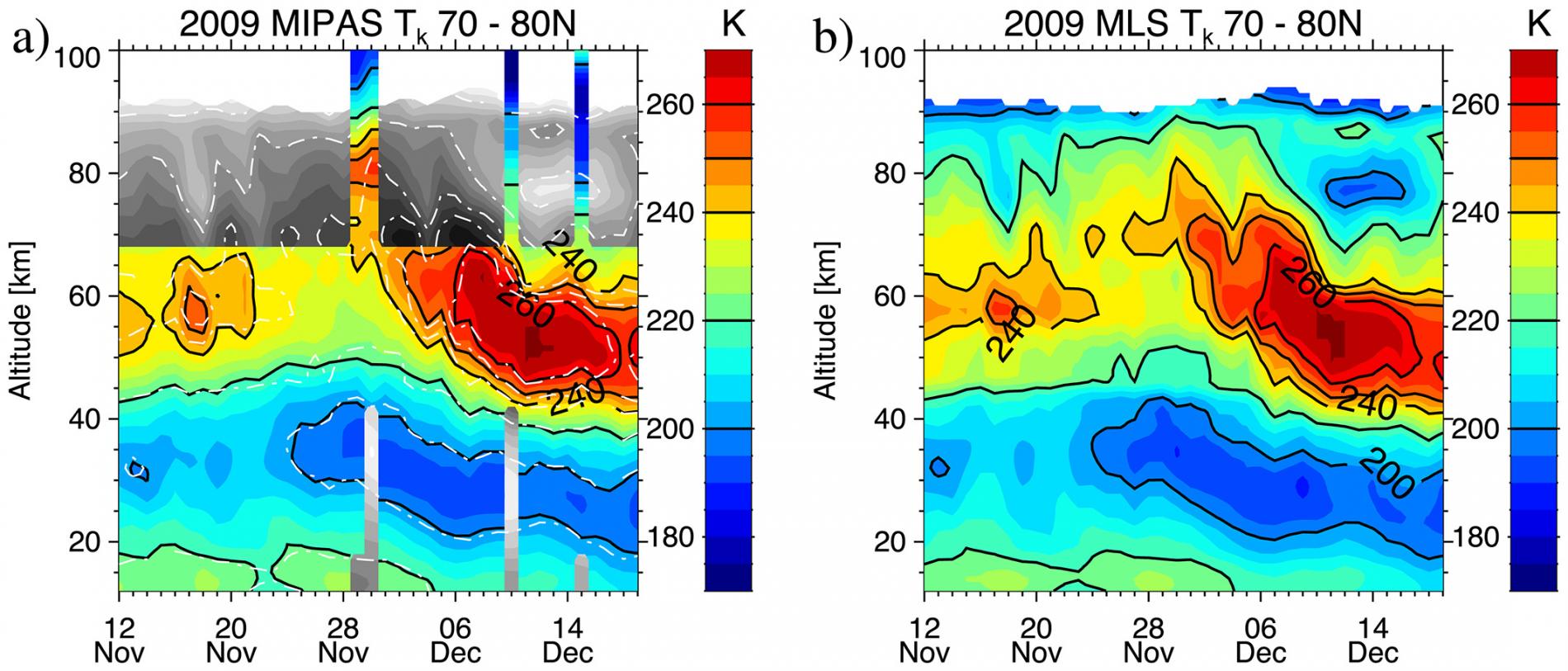First detection in autumn of an elevated stratopause, a winter atmospheric phenomenon
Researchers from the Institute of Astrophysics of Andalusia detect, in data files from 2009, an elevated stratopause in November, a phenomenon never seen outside the winter period
The Earth's atmosphere is divided into five layers (troposphere, stratosphere, mesosphere, thermosphere, and exosphere), a division that attends to the air temperature in each region and that does not establish a rigid division: the atmosphere is a dynamic and highly coupled system and what happens in one region can influence another, so the height of the layers can vary. One of these well-documented changes are elevated stratopauses, winter phenomena in which the stratosphere can reach 85 kilometers, well above the 50 to 55 kilometers at which, under normal conditions, this layer ends. Now, researchers from the Institute of Astrophysics of Andalusia (IAA-CSIC) have detected this phenomenon in autumn, something never seen before.
The stratosphere ranges from 10 to 50-55 kilometers high and is rich in ozone, which absorbs harmful radiation from the sun. In this layer the air temperature rises to a maximum with height, the stratopause, which establishes the division with the next layer, the mesosphere, in which the temperature falls with height. The stratopause is the transition region between both layers, located, depending on the latitude and the season, between 50 and 55 kilometers above sea level.

A PHENOMENON OUT OF SEASON
"Elevated stratopauses occur in polar latitudes after some sudden stratospheric warming, which in turn is the consequence of an intensification of the activity of planetary waves generated at the surface. They are a very good example of atmospheric coupling, through which some atmospheric regions respond to phenomena originating from others - says Maya García-Comas, researcher at the Institute of Astrophysics of Andalusia (IAA-CSIC) who coordinates the study-. Stratospheric warm-ups capable of generating stratopauses at high altitudes are not rare in the middle of winter, but they are in November. So detecting an elevated stratopause at this time of year is the least surprising”.
The MIPAS instrument, on board the Envisat mission, measured the stratopause over Greenland at 82 kilometers for a few days in November 2009, a very high altitude compared to its climatological height in the winter season of about 55 kilometers. It was a small-scale phenomenon, with an extension and duration less than typical midwinter, but equally extraordinary. "Two anticyclones formed in the lower stratosphere, the stratopause disappeared a few days and re-emerged more than 25 kilometers above its climatological height, showing considerable longitudinal asymmetry. The stratopause took a little over a week to recover its usual height ”, details Maya García-Comas (IAA-CSIC).

The study of elevated stratopauses allows a better understanding of the energy transfer mechanisms between the planet's surface and the middle and upper atmosphere, as well as the distribution of the different atmospheric compounds, which is altered in this type of episode: for example, vertical air transport in the lower mesosphere is intensified, leading to further destruction of stratospheric ozone.
The elevated stratopause of November 2009 is, until now, a unique phenomenon and somewhat different from those previously registered, so the group of researchers has called it BM-ES, an acronym for “brief mesoscale elevated stratopause”. Its ultimate origin, outside the winter season, is not entirely clear. "We know that climate change affects the variability in the activity of planetary waves originating at the surface. As this is the only known event of this type, it is still early to know if it has any relation to climate change. In any case, it requires us to remain vigilant and examine the data to check whether it is an exception or a recurring phenomenon", concludes Maya García-Comas (IAA-CSIC).
M. García-Comas et al. "First detection of a Brief Mesoscale Elevated Stratopause in very early winter". Geophysical Research Letters (Feb 2020). DOI: https://doi.org/10.1029/2019GL086751
Instituto de Astrofísica de Andalucía (IAA-CSIC)
Unidad de Divulgación y Comunicación
Silbia López de Lacalle - sll[arroba]iaa.es - 958230676
https://www.iaa.csic.es
https://divulgacion.iaa.csic.es

